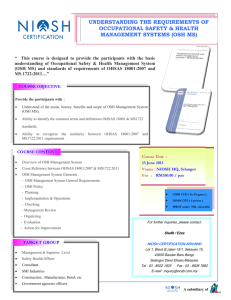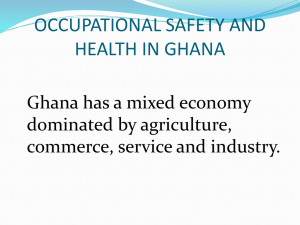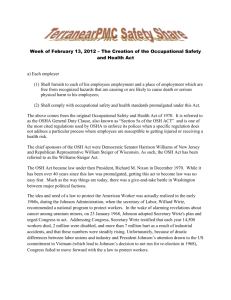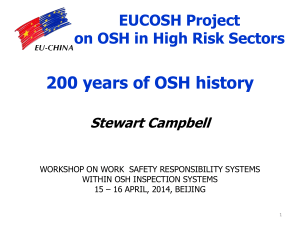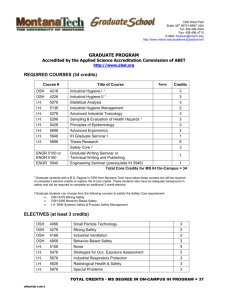Full PDF - Quest Journals
advertisement
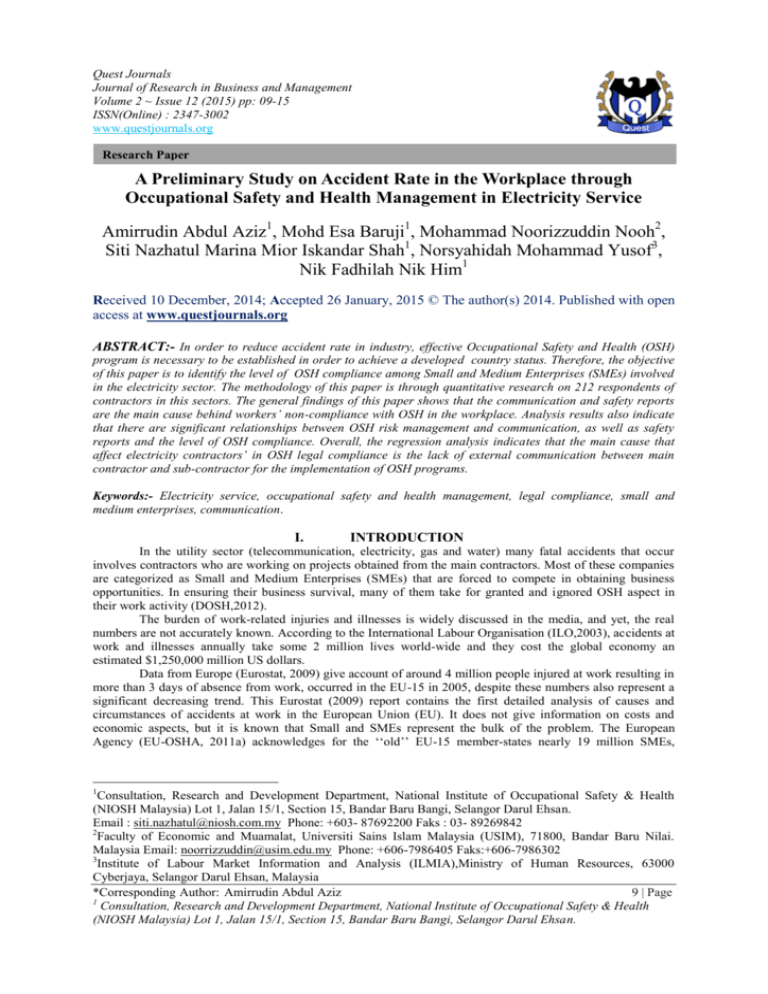
Quest Journals Journal of Research in Business and Management Volume 2 ~ Issue 12 (2015) pp: 09-15 ISSN(Online) : 2347-3002 www.questjournals.org Research Paper A Preliminary Study on Accident Rate in the Workplace through Occupational Safety and Health Management in Electricity Service Amirrudin Abdul Aziz1, Mohd Esa Baruji1, Mohammad Noorizzuddin Nooh2, Siti Nazhatul Marina Mior Iskandar Shah1, Norsyahidah Mohammad Yusof3, Nik Fadhilah Nik Him1 Received 10 December, 2014; Accepted 26 January, 2015 © The author(s) 2014. Published with open access at www.questjournals.org ABSTRACT:- In order to reduce accident rate in industry, effective Occupational Safety and Health (OSH) program is necessary to be established in order to achieve a developed country status. Therefore, the objective of this paper is to identify the level of OSH compliance among Small and Medium Enterprises (SMEs) involved in the electricity sector. The methodology of this paper is through quantitative research on 212 respondents of contractors in this sectors. The general findings of this paper shows that the communication and safety reports are the main cause behind workers’ non-compliance with OSH in the workplace. Analysis results also indicate that there are significant relationships between OSH risk management and communication, as well as safety reports and the level of OSH compliance. Overall, the regression analysis indicates that the main cause that affect electricity contractors’ in OSH legal compliance is the lack of external communication between main contractor and sub-contractor for the implementation of OSH programs. Keywords:- Electricity service, occupational safety and health management, legal compliance, small and medium enterprises, communication. I. INTRODUCTION In the utility sector (telecommunication, electricity, gas and water) many fatal accidents that occur involves contractors who are working on projects obtained from the main contractors. Most of these companies are categorized as Small and Medium Enterprises (SMEs) that are forced to compete in obtaining business opportunities. In ensuring their business survival, many of them take for granted and ignored OSH aspect in their work activity (DOSH,2012). The burden of work-related injuries and illnesses is widely discussed in the media, and yet, the real numbers are not accurately known. According to the International Labour Organisation (ILO,2003), accidents at work and illnesses annually take some 2 million lives world-wide and they cost the global economy an estimated $1,250,000 million US dollars. Data from Europe (Eurostat, 2009) give account of around 4 million people injured at work resulting in more than 3 days of absence from work, occurred in the EU-15 in 2005, despite these numbers also represent a significant decreasing trend. This Eurostat (2009) report contains the first detailed analysis of causes and circumstances of accidents at work in the European Union (EU). It does not give information on costs and economic aspects, but it is known that Small and SMEs represent the bulk of the problem. The European Agency (EU-OSHA, 2011a) acknowledges for the ‘‘old’’ EU-15 member-states nearly 19 million SMEs, 1 Consultation, Research and Development Department, National Institute of Occupational Safety & Health (NIOSH Malaysia) Lot 1, Jalan 15/1, Section 15, Bandar Baru Bangi, Selangor Darul Ehsan. Email : siti.nazhatul@niosh.com.my Phone: +603- 87692200 Faks : 03- 89269842 2 Faculty of Economic and Muamalat, Universiti Sains Islam Malaysia (USIM), 71800, Bandar Baru Nilai. Malaysia Email: noorrizzuddin@usim.edu.my Phone: +606-7986405 Faks:+606-7986302 3 Institute of Labour Market Information and Analysis (ILMIA),Ministry of Human Resources, 63000 Cyberjaya, Selangor Darul Ehsan, Malaysia *Corresponding Author: Amirrudin Abdul Aziz 9 | Page 1 Consultation, Research and Development Department, National Institute of Occupational Safety & Health (NIOSH Malaysia) Lot 1, Jalan 15/1, Section 15, Bandar Baru Bangi, Selangor Darul Ehsan. A Preliminary Study on Accident Rate in the Workplace through Occupational Safety and Health Mgt… employing just about 75 million people; these SMEs, per se, contribute to around 82% of all occupational injuries, rising to about 90% of fatal accidents. According to the US Energy Information Administration (2010), more than 4 billion mW of electricity is generated annually in the United States to serve more than 300 million people. This electricity is transmitted for consumption through electrical transmission and distribution (T&D) lines. Workers involved in the construction and maintenance of these electrical T&D lines are at extremely high risk of electrocution. Other major causes of occupational electrocutions included contact with wiring, transformers, or other electrical components (27%) and contact with the electrical current of machines, tools, appliances, or light fixtures (17%) (A. Alex, 2013). Among all occupations, the Electrical Safety Foundation International (2010) found that construction contractors account for the highest rate of electrocutions. Within the construction trade, electricians accounted for 17% of the electrocution fatalities; construction labourers accounted for 9%; and roofers, painters, carpenters, and maintenance workers incurred a total of 7%. Behind construction, T&D line workers have the second highest electrocution rate. The Bureau of Labour Statistics (2010a) estimated that among the 192 recorded electrocution fatalities in 2008, 53% involved T&D workers who contacted overhead power lines and the National Institute for Occupational Safety and Health (2009) documented that 80% of fatalities among linemen have occurred due to direct contact with T&D power lines. This injury rate caused the Bureau of Labour Statistics (2010b) to classify T&D line construction and maintenance as one of the most dangerous jobs in the American economy. In Malaysia, based on the Ministry of Human Resources, the Department of Occupational Safety and Health (DOSH, 2012), reported that compared to the other sectors, the electricity wiring sector recorded the highest number of fatal accidents in 2009 and 2010, with 71 and 66 deaths of the workers respectively. Therefore, this study will focus on the electricity sector, which is main electricity contractors in SMEs categories in Kuala Lumpur and Selangor with the hope to assist workers to reduce number of accidents happen at the workplaces in future. Based on the Energy Commission statistic from 2002 to 2010 in Malaysia electricity services, the increasing of fatal accident has occurred from 0.58 person per one million workers in 2002 to 1.57 per one million workers in 2007 and it starts decreasing to 1.32 per one million workers in 2010. Whereas, for non-fatal accident, 0.94 per one million workers population in 2002 has increased to 2.13 person per million workers in 2006. After that, a significant decline occurred in 2009 and increased again to 2.14 person per million for the year of 2010. Hence, a specific research pertaining to the OSH practice within SME in this sector is deemed necessary. It is to examine methods for further improving the level of OSH understanding and compliance at workplace among the contractors. II. LITERATURE REVIEW The Malaysian SME industry needs to confront challenges, either the traditional one as well as the new ones. One of the challenges that needs to become fronted is the high rate of work-related accidents that occur in the workplace. The rate reflects the attitude of the workers who work in the SME industry. Evidently, SOCSO report (2010-2012) stated that 80 to 90% of work-related accidents involved workers from the SME industry. According to Biddle (2013), during the first decade of National Occupational Research Agenda (NORA), the total number and rate per 100 full-time workers of occupational injuries declined by 33% and 39% respectively. In the second decade of NORA through 2010, the number of occupational injuries dropped from 3.9 million in 2006 to 2.9 million in 2010- a 25% decline. This paper provides the first step in identifying the burden to society by deriving the societal costs of fatal occupational injuries occurring in the U.S. Workplace accidents are preventable if employers and their employees are more sensitive towards safety issues or have good safety behaviour (Makin & Sutherland, 1994). Effective OSH implementation will facilitate in the development of good safety behaviour. This is because the implementation of OSH regulations requires for the employers’ commitment in fulfilling their employees’ safety needs. The employees, on the other hand, must have the sense of responsibility to take care of their own safety. Substantial financial resources are required to implement OSH and it is a huge investment by a company. Once a company invests its financial resources, it expects for the investment to benefit every worker in the company. In this situation, large companies have the advantage of having more workers, and thus the various OSH programs conducted can be disseminated to the other workers. It is also beneficial to the workers. As for the SMEs, OSH is seen as irrelevant because they do not have huge manpower and the implementation is not profitable to such companies. Hence, OSH seems unimportant to them (Lahm, 1997; McKinney, 2002). Standard Operation System (SOP) intended to assist in development process of workplaces for lodges, equipment, hazardous materials, work task and process that have potential to cause danger to human or *Corresponding Author: Amirrudin Abdul Aziz 10 | Page A Preliminary Study on Accident Rate in the Workplace through Occupational Safety and Health Mgt… environment and identified from risk assessment. The purpose for SOP may be identified by using hierarchy escort in hazard management procedures. Development and the used of SOPs are an integral part of successful quality system as it provides individuals with information to do the job properly and facilitates consistency in the quality and integrity of the product or end result (OHSW&IM Procedure,2011). The electricity industry is one of the industries in the utility sector which consists of small and medium enterprises. In this sector, task lists and restrictions will increase the knowledge on electricity safety. However, they are often not recognized and thus do not influence a person’s perception. As a result, it creates ignorance towards OSH among the workers. Thus, it is very crucial for the workers to have the understanding about the importance of safety measures and the awareness that electricity accidents can occur within a split second (Kruse, 2013). Measures such as accident preventive trainings, OSH campaigns, posters, charts and seminars must be done frequently in order to increase the awareness and attention on OSH in the workplace (Junaidi, 2004). Good OSH management system at the workplace is necessary in creating a safe work environment. The OHSAS 18001 (Occupational Health and Safety Assessment Series) is a requirement for the OSHMS in order to facilitate the organization in taking control of OSH risks and in improving organizational performance. With regard to this matter, Malaysia via SIRIM QAS International Sdn. Bhd., together with 13 agencies worldwide, were involved as the committee (which is lead by the British Standard Institute) in the formation of OHSAS 18001 guidelines. Thus, in 1999 SIRIM started the campaign on the implementation of OHSAS 18001 among the organizations in this country. The OSHMS, which is based on the OHSAS 18001 series is more similar to The OSHMS that was specifically developed to protect the workers’ welfare in terms of their safety and health. Besides that, it is also positively beneficial to the organizations that implement it (Kadir, Kadaruddin, Azhar & Muhamad, 2009). Saksvik, Torvatn and Nytro (2003) suggest that the implementation of a systematic approach, such as the cooperation between the government and the employers, is very important pertaining to this issue. Based on this study, the SMEs’ lack of financial resources to implement OSH is resolved through the provision of government subsidy, which will help them to achieve the implementation. The initiatives of the management such as the provision of remuneration, training and investment in the environment is crucial in the successful implementation of OSH (Gilkey, Keefe, Hautaluoma, Bigelow, Herron, & Stanley, 2003; Ashill, Carruthers, & Krisjanous, 2006). The commitment given by the management in implementing and complying with OSH regulations is more effective in raising the level of OSH awareness, as compared to isolated practices (for example, the setting of goals and penalties) which are carried out without such commitment from the management (Barling & Hutchinson, 2000). This indicates that compliance with OSH as initiated by the top management is essential for the success of OSH, and leads to their reduction in accident rates. Ashill, Carruthers and Krisjanous (2006) stated that managerial commitment is shown through several ways, such as educating or giving training in OSH, or in rewarding and empowering workers to make decisions in the OSH field. The investment in OSH education and training will give workers the opportunity to learn the required OSH knowledge and later help them to work safely. In addition, the action of rewarding workers who report on the unsafe behaviour of their co-workers is an important aspect in the successful implementation of OSH. Thus, SMEs management must show high level of commitment towards the implementation of OSH despite its organizational structure which generally fits just a tiny structure consisting of a managing director who often acts as a finance manager and also a human resources manager as well. Due to the small scale of the company, the increase in the number of workers will increase the company cost, thus workers are usually assigned with several job responsibilities. According to Vassie, Tomas and Oliver (2000), SMEs management spends too little time to resolve safety issues which is a widespread phenomenon in the United Kingdom and Spain. Other researches in the industrial countries have proven that 90% of the accidents in the workplace are caused by the errors made by the workers, and only 10% are caused by the unsafe workplace condition, as well as the usage of unsuitable equipment (Fleming & Lardner, 2002). Some of the factors that cause workers to make work-related errors are lack of knowledge, lack of interest, negative attitude, unsafe behaviour and incompetency. Lack of interest is one of the most important factors which contributes to the failure in the promotional campaign plan of OSH at the workplace. The provision of education is vital in the effort to change the attitude of these type of workers from behaving riskily to behaving safely, so that they will comply with OSH regulations in the attempt to develop safe behavior (Niven, 1999; Sue, Bethman & Helen, 2004; Kamp & Krause, 1997). *Corresponding Author: Amirrudin Abdul Aziz 11 | Page A Preliminary Study on Accident Rate in the Workplace through Occupational Safety and Health Mgt… Thus, this study is focus on identifying the level of OSH compliance at the workplace among the SMEs contractors in this sector and to propose for improvement action, which could indirectly reduce the rate of accident and occupational disease that create losses to the country’s productivity. III. METHODOLOGY This is a cross-sectional study that examines the OSH management and its impact in reducing the number of accidents in the workplace. This study was conducted by through questionnaire form that was constructed in order to obtain comprehensive research information. The form consists of 9 parts which are Part A: Respondents’ Profile, Part B: Company’s Profile, Part C: Training and Supervision (10 statements), Part D: Standard Operating Procedures (SOP) (11 statements), Part E: OSH Risk Management (11statements), Part F: Communications / OSH Report (9 statements), Part G: Managerial Commitment (5 statements), Part H: Employee Attitude towards OSH (5 statements) and Part I: Suggestions. Besides, in field work activities, site visits to all zones which involves the distribution of questionnaires, conducting interviews and the observation of the target group in the electricity sector which involved the main contractors and the SMEs’ sub-contractors were done. The respondents involved in this study were workers aged 18 years old and above and the organization was registered as contractor with electricity multinational company. There were 283 organizations until the 5th of December 2013 in the database. Krejcie & Morgan (1970) state that the increasing demand in research has created the need for efficient method in determining the required sample size. In the Small Sample Techniques article, it states the formula to easily and accurately determine the sample size. Thus, the Krejcie & Morgan (1970) formula was used to calculate the number of respondents that should be involved in the research. The calculation is as follows: s = X2NP(1P) d2(N1)+(X2P(1P) Indicators: s = the needed sample size N = population (283) P = the population proportion estimated at 0.5 as the magnitude will produce maximum sample size. d = degree of maximum accuracy X2 = the chi-square value for 1 degree of freedom at the desired confidence level of 3.841. Calculation: s= (3.841)(283)(0.5)(1-0.5) (0.05)2(283-1)+3.841(0.5)(1-0.5) = 271.75075 1.66525 = 163.19 = 212 (addition 30%) The above formula produced the sample size (s) = 163, and an additional 30% (49) of this amount was allocated to offset the possibility of questionnaires not returned or loss of data as proposed by Israel G.D (1992). Therefore, the total number of 212 questionnaires were distributed randomly to the respondents involved which categorized as SME as defined by SME Corporation in Guideline For New SME Definition, October 2013 i.e. having more than 5 peoples or earning more than RM300,000 and having less than 75 peoples or earning below RM20 million were involved in the study. Convenience sampling method was used in which the questionnaire was given directly to the main electricity service contractor representatives. All the data obtained was analyzed using the latest version of the Statistical Package for Social Sciences (SPSS). Meanwhile, the numerical scale used in questionnaire is as follows: 1 2 3 4 5 6 Scale Description Strongly Disagree Disagree *Corresponding Author: Amirrudin Abdul Aziz Partially Disagree Partially Agree Agree Strongly Agree 12 | Page A Preliminary Study on Accident Rate in the Workplace through Occupational Safety and Health Mgt… IV. FINDINGS A pilot study to 40 respondents only was conducted on the questionnaire questions before they can be used in the actual fieldwork. Questionnaire pilot study is a tool to ensure that the reliability and validity index of the questions achieve the range between 0.7 and 0.9 (Hair et. al. 1998) before they can be distributed to the MANIPULATED VARIABLES Training and Supervision Safe Operating Procedures OSH Risk Management Communications & Safety Report Managerial Commitment Employee Attitude towards OSH CRONBACH’S ALPHA 0.946 0.961 0.966 0.939 0.942 0.916 ITEM NO. 10 11 16 9 6 4 actual respondents. Table. 1. Reliability and validity analysis for each statement Based on the table 1, it can be seen that the reliability value of each manipulated variable is high; where most are within 0.9 and approaching 1.0. In conclusion, all of the statements provided could be easily understood by the respondents. CHARACTERISTIC Sex Male Female Age 18 to 25 years 26 to 45 years 46 to 55 years 56 years and above Job status Permanent Contract Work Experience 1 to 10 years 11 to 20 years More than 20 years Level of education SPM Certificate Diploma Bachelor degree Master Other Note : n=212 N % 193 19 91 9 2 76 123 9 1 36 59 4 157 47 77 23 145 23 2 85 14 1 13 11 34 37 3 1 13 11 35 37 3 1 Table 2 . Detail characteristic of respondent Table 2 shows the characteristic of the respondents. Based on the above table, 91% (193 respondents) are male and 9% (19 respondents) are female. Besides, 59% (123 respondents) of the contractor’s representatives are between 46-55 years old, which is the highest age range. This is followed by those between 26-45 years old with 36% (76 respondents). Meanwhile, the third highest age range is those aged 56 years and above, and the lowest percentage goes to the representatives aged 18-35 years. Moreover, 77% of the respondents are on permanent status, while the other 23% are on contract status. Part Mean Score Training And Supervision (C) Safe Operating Procedure (SOP) (D) OSH Risk Management (E) *Corresponding Author: Amirrudin Abdul Aziz Skewness -.357 -.604 -.525 13 | Page A Preliminary Study on Accident Rate in the Workplace through Occupational Safety and Health Mgt… Communication And Safety Reporting (F) Management Commitment (G) Attitude Of Workers Towards OSH (H) Table 3. Skewness for each statement -.380 -.617 -.711 Table 3 shows that all sections are skewed approaching -1.0. For training and supervision section, the skewed are -0.357 . For SOP section, the skewed are -0.604 while for OSH risk management section and communication and safety reporting section, the skewed are -0.525 and -0.380 respectively. Moreover, the management commitment section and attitude of workers toward OSH section also skewed to -0.617 and -0.711 respectively. In conclusion, all of the sections above are normally distributed. Manipulated Variables Training and Supervision Safe Operating Procedure OSH Risk Management Communication Managerial Commitment Attitude Of Workers Towards OSH Mean 4.72 4.56 4.56 4.61 4.57 4.69 Standard Deviation 0.81 0.91 0.91 0.85 0.95 0.92 Table 4. Descriptive Analysis for each Statement Based on the table 4, training had recorded the highest mean value of 4.72 in the aspect of occupational safety and health (OSH) legal and level of compliance issues. Similarly, the standard deviation recorded the lowest value (0.81), which means that the standard deviation for each value of the Likert Scale answered by each respondent was 0.81.The deviation rate is less and this leads to more accurate data set distribution. In conclusion, training is an important variable for workers in small and medium enterprises (SMEs) in the electricity sector; this is followed by other variables such as communication, procedures and OSH, attitude and lastly management. V. CONCLUSION Based on the research findings, it is discovered that training and supervision scored the highest mean of 4.72. This shows that all of the electricity contractors have implemented the training and supervision well. Meanwhile, there are two (2) lowest aspects which are SOP and OSH Risk Management. Both scored the same mean of 4.56. Hence, the SOP and OSH Risk management should be given priority to be improved in order to enhance the level of OSH compliance among SMEs involved in the electricity sector. Based on the researchers’ evaluation, this research has the potential to be further researched. It is important for the sake of finding the best method to improve the level of OSH compliance, which would reduce the rate of accidents among contractors who are involved in the electricity service. ACKNOWLEDGEMENT Author would like to thank ILMIA and NIOSH Malaysia, an agency under Ministry of Human Resource Malaysia for funding this project. Special thanks to all respondents that involve in this project and all research members in contributing knowledge and input to complete this research project successfully. REFERENCES [1]. [2]. [3]. [4]. [5]. [6]. [7]. Abdul Rahman Bakar. (Januari 9, 2007). Menangani risiko bahan kimia. Berita harian, p.11. Azizah (2010). Kaedah Kualitatif Dalam Penyelidikan Sosiobudaya .Selangor : Pengajian Media Malaysia Barling, J. and Hutchinson, I. (2000). Commitment vs Control-based Safety Practices, Safety Reputation, and Perceived Safety Climate. Revue Canadienne des Sciences de I’Administration. 17:76. Cooper, D. (2006). Exploratory Analyses of the Effects of Managerial Support and Feedback Consequences. Journal of Organizational Behaviour Management. 26: 41-82. Dayang Tiawa, Hafidz & Ahmad and Sumarni, Rio (2005) Aplikasi Perisian NVIVO Dalam Analisis Data Kualitatif. In: Qualitative Conference, 21-23 August 2005, Sofitel Resort Senai. DOSH Annual Report (2010 – 2012). Ministry of Human Resouces, Malaysia. Fleming M, Lardner R (2002). Strategies to promote safe behavior as part of a health and safety management system. Contact Research Report, 430-38. *Corresponding Author: Amirrudin Abdul Aziz 14 | Page A Preliminary Study on Accident Rate in the Workplace through Occupational Safety and Health Mgt… [8]. [9]. [10]. [11]. [12]. [13]. [14]. [15]. [16]. [17]. [18]. [19]. [20]. [21]. [22]. [23]. [24]. [25]. [26]. [27]. [28]. [29]. [30]. [31]. [32]. [33]. [34]. [35]. Gilkey, D.P., Keefe, T.J., Hautaluoma, J.E., Bigelow, P.L., Herron, R.E. and Stanley, S.A. (2003). Management commitment to safety and health in residential construction:HomeSafe spending trends 1991–1999. Work Safety. 20: 35-44. Guideline For New SME Definition (October 2013). SME Corp. Malaysia Secretariat to the National SME Development Council. Hair, J. F., Anderson, R. E., Tatham, R. L. dan Black, W. C. (1998). Multivariate Data Analysis (5th ed). New Jersey: Prentice Hall International, Inc. Israel, G.D. (1992). Sampling Issues: Nonresponse. IFAS, University of Florida, Gainesville. Jabatan Keselamatan Elektrik. (2007). Analisa Statistik Kemalangan Elektrik 2002-2006. Suruhanjaya Tenaga, Malaysia. Jaselskis, E. J. and Suazo, G. (1993). A survey of construction site safety in Honduras.Construction Management and Economics. 12: 245-255. Johnston, D.D. (1994). The Art and Science of Persuasion. p 16. John Wiley & Sons, Inc. Junaidi, A.B. (2004). The Practice of Human Resouce Management in the Management of Industrial Safety in Malaysia. Communication Journal. 95:115. Kadir, A., Kadaruddin, A., Azhar, A. & Muhamad Rizal. R (2009). Occupational Safety and Health Management System (OSHAH:18001) An Analysis of the Acceptance of Its Implementation Benefits to the Organizations in Malaysia . Journal Of Techno Social. 1:1-16. Kruse, K. (2013). Putting a face on safety: Changing attitude to promote a climate of safety. Energy Education Council. New Jersey : Prentice Hall International, Inc. Noor Azlan B. Ahmad Zanzali & Mohd Nazri Bin Hamid (2010). Kesediaan Guru Program Pengijazahan Perguruan (PKPG) UTM Terhadap Mengajar Mata Pelajaran Sains Dan Matematik Dalam Bahasa Inggeris: Universiti Teknologi Malaysia. Kamp J, Krause TR (1997). Selecting safe employees: a behavioral science perspective. Professional safety.Am J Health System Pharmacology, 42 (4): 24-8. Koh, D. and Jeyaratnam, J. (1998). Occupational Health in Singapore. International Archives of Occupational and Environmental Health. 71: 295-301. Kamarul Shukri Mat Teh & Mohamed Amin Embi (2012). Korelasi Strategi Dengan Motivasi Dalam Pembelajaran Bahasa Arab Jurnal Pendidik dan Pendidikan. 24, 109–123. Krejcie, R. V. & Morgan, D. W. 1970). Determining sample size for research activities. Educational and Psychological Measurement 30(3): 607–610. Lahm, F. (1997). Small business and occupational health and safety advisors. Safety Science. 25:153161. Lilis Surienty, Khoo teng Hong & Daisy Kee Mui Hung. (2011). Occupational safety and health in SMES in Malaysia: A preliminary investigation. Journal of Global Entrepreneurship.1:1. Makin, P.J. and Sutherland, V.J. (1994). Reducing Accidents Using a Behavioural Approach.Leadership & Organization Development Journal. 15: 5-10. McKinney, P. (2002). Expanding HSE’s ability to communicate with small firms: A targeted approach (No. 420/2002): Prepared by AEA Technology plc for the Health and Safety Executive. Mizoue, T., Huuskonen, M. S., Muto, T., Koskinen, K., Husman, K. and Bergstrom, M.(1999). Analysis of Japanese Occupational Health Services for Small- and Mediumscale Enterprises in Comparison with the Finnish System. Journal of Occupational Health. 41: 115-120. National Institute Of Occupational Safety And Health (NIOSH) Certification (2013). Retrieve from http://www.ncsb.com.my/index.php?option=com_content&view=category&layout=blog&id=55&Itemid =277 date retrieved on 13 Julai 2014. Niven. K (1999). Accident costs in the NHS. The Safety and Health Practice, 17(9): 34-8. Occupational Safety and Health Master Plan For Malaysia 2015 (OSH-MP 15). Ministry of Human Resources. Raouf A, Dhillon BS (1995). Safety assessment. London : Luis Publisher, 1-10. Saksvik, P. O., Torvatn, H. and Nytro, K. (2003). Systematic occupational health and safety work in Norway: a decade of implementation. Safety Science. 41: 721-738. SOCSO Annual Report (2010 -2012). Ministry of Human Resouces, Malaysia. Sabitha Marican. (2006). Penyelidikan Sains Sosial: Pendekatan Pragmatik. Selangor: Edusystem Sdn. Bhd. Teo, A. L. and Phang, T. W. (2005). Singapore’s Contractors’ Attitudes Towards Safety Culture. Journal of Construction Research. 6: 157-178. Vassie, L., Tomas, J. M. and Oliver, A. (2000). Health and Safety Management in UK and Spanish SMEs: A Comparative Study. Journal of Safety Research. 31: 35-43. *Corresponding Author: Amirrudin Abdul Aziz 15 | Page
